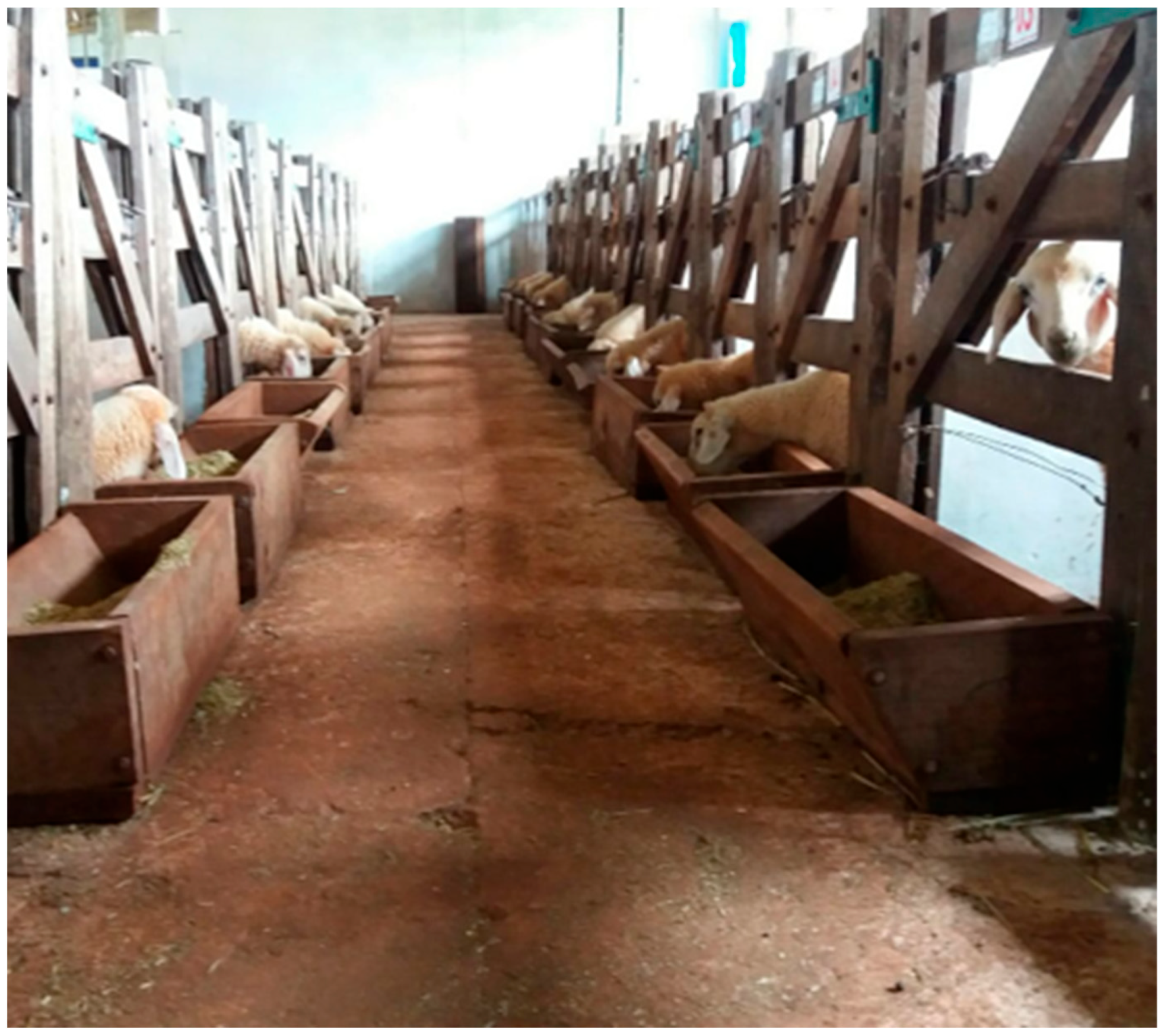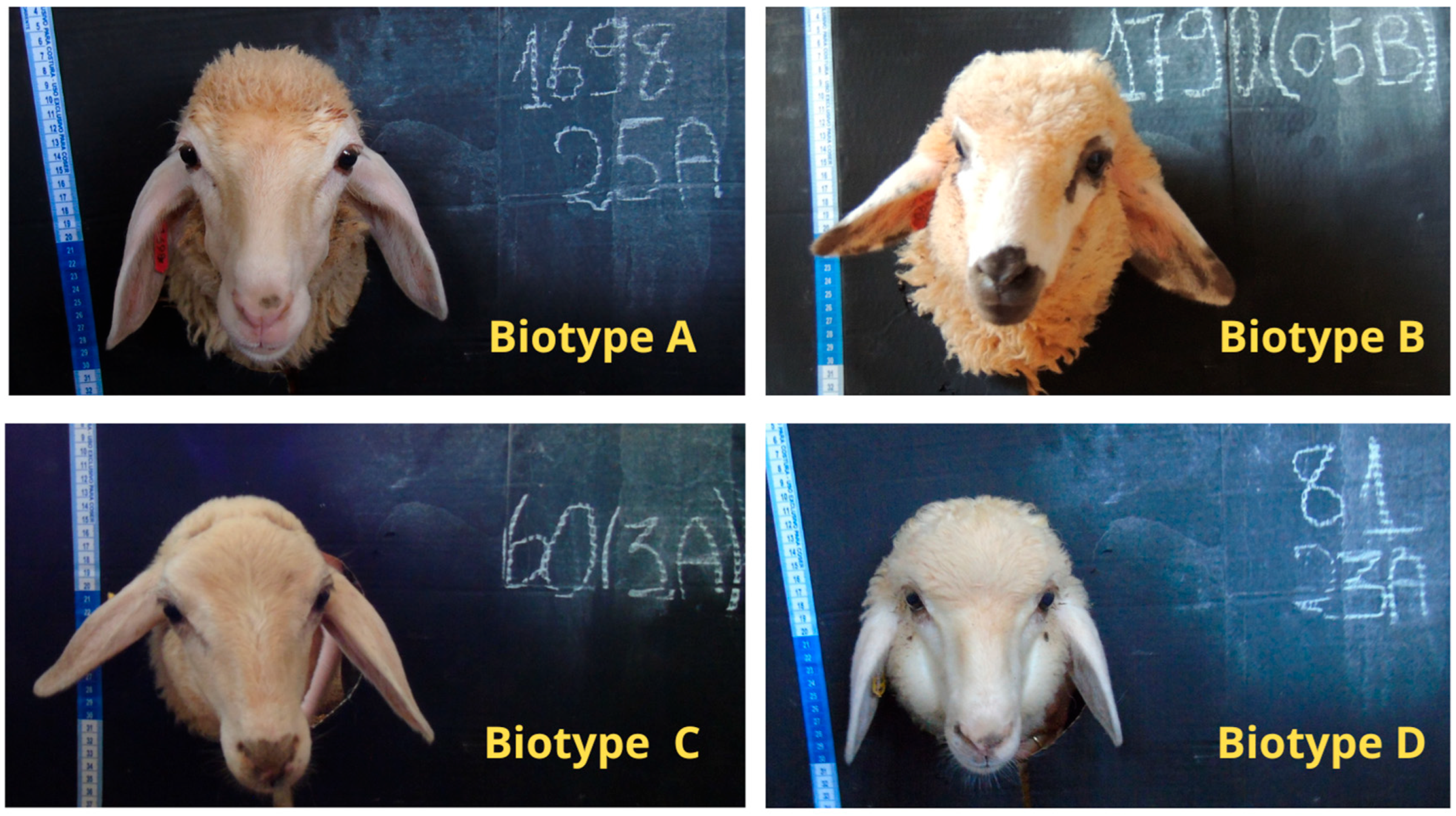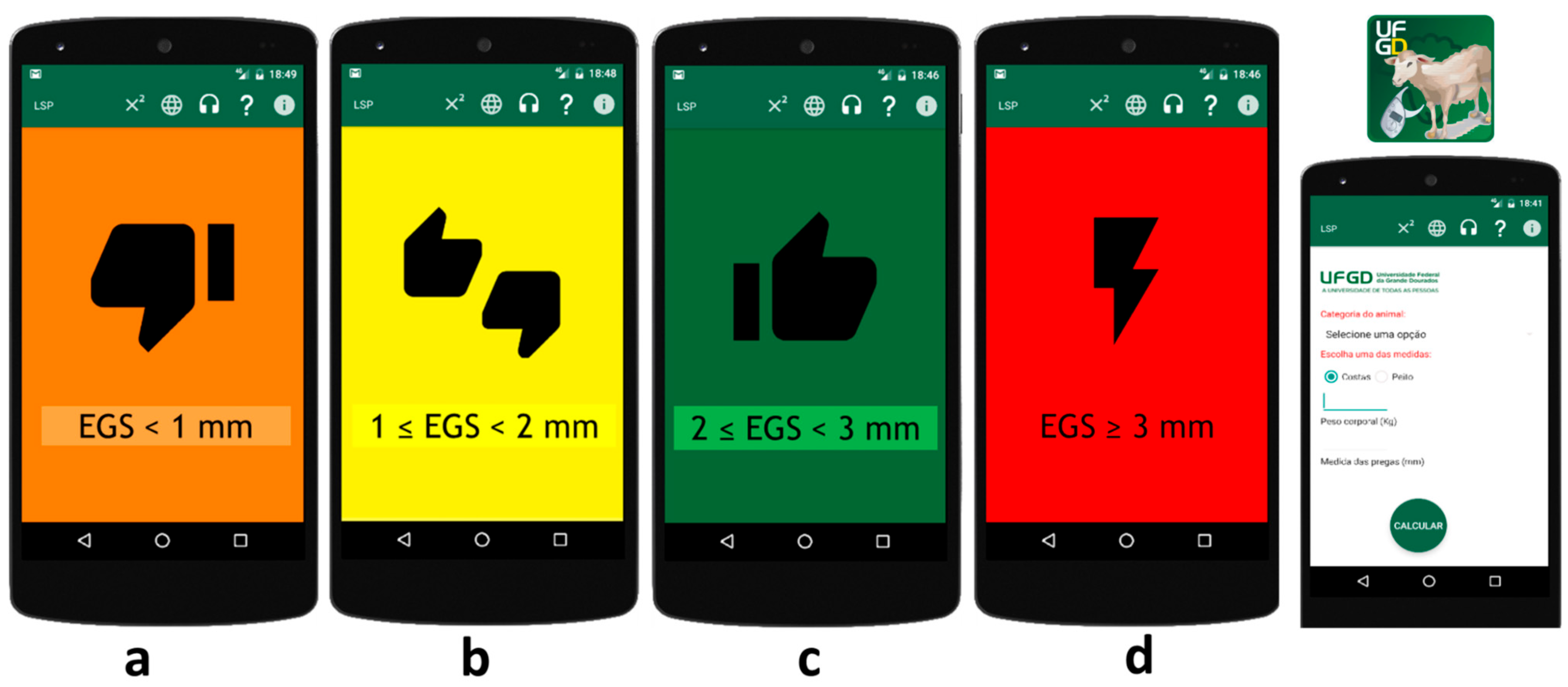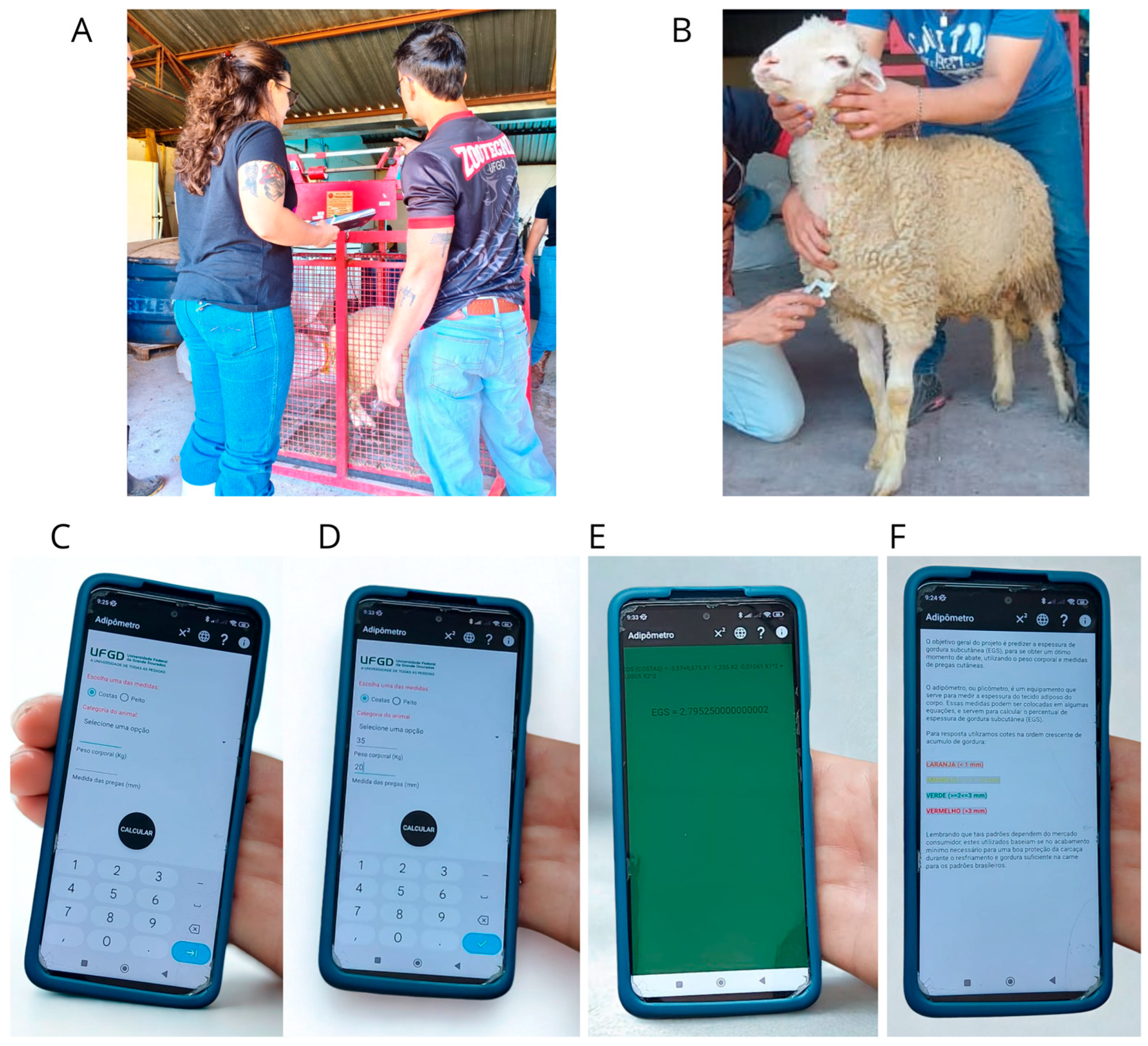Prediction of Subcutaneous Fat Thickness (SFT) in Pantaneiro Lambs: A Model Based on Adipometer and Body Measurements for Android Application
Abstract
1. Introduction
2. Materials and Methods
2.1. Experimental Location
2.2. Experimental Animals and Diets
2.3. Animal Slaughter
2.4. Statistical Analysis
2.5. Mobile App Development
3. Results
3.1. Multivariate
3.2. Univariate
3.3. Regression Models for Predicting Subcutaneous Fat Thickness (SFT)
3.4. Mobile Application for Predicting the Slaughter Point
4. Discussion
4.1. Multivariate
4.2. Univariate
4.3. Predictive Regressions
5. Conclusions
Author Contributions
Funding
Data Availability Statement
Acknowledgments
Conflicts of Interest
References
- Khan, R.; Li, A.; Raza, S.H.A. Editorial: Genetic Regulation of Meat Quality Traits in Livestock Species. Front. Genet. 2023, 13, 1092562. [Google Scholar] [CrossRef] [PubMed]
- da Silveira Osório, J.C.; Osório, M.T.M.; Fernandes, A.R.M.; de Oliveira Seno, L.; de Almeida Ricardo, H.; Rossini, F.C.; Junior, M.A.P.O. Revista Agrária Critérios para abate do animal e a qualidade da carne Critérios para abate de animais e qualidade da carne. Agrarian 2012, 5, 433–443. [Google Scholar]
- Alves, L.G.C.; Cunha, C.M.; da Fernandes, A.R.M.; de Vargas Junior, F.M.; Hirata, A.S.O.; Paes, M.R.S.; Messa, R.S. Perfil do consumidor de carne ovina na cidade de Dourados—MS. Agrarian 2017, 10, 289–293. [Google Scholar] [CrossRef]
- Alves, L.G.C.; de Azambuja Ribeiro, E.L.; Fernandes, A.R.M.; de Vargas Junior, F.M.; Hirata, A.S.O.; da Cunha, C.M. Predição das características na carne de cordeiros comerciais e pantaneiros por meio das medidas in vivo e na carcaça. Agrarian 2021, 14, 244–259. [Google Scholar] [CrossRef]
- Junior, F.M.V.; Martins, C.F.; Feijó, G.L.D.; Teixeira, A.; Leonardo, A.P.; Ricardo, H.d.A.; Fernandes, A.R.M.; Reis, F.A. Evaluation of genotype on fatty acid profile and sensory of meat of indigenous Pantaneiro sheep and Texel or Santa Inês crossbred finished on feedlot. Small Rumin. Res. 2019, 173, 17–22. [Google Scholar] [CrossRef]
- Mora, N.; Macedo, F.; Mexia, A.; Dias-Senegalhe, F.; Oliveira, E.; Radis, A. Características de carcaça de cordeiras Pantaneiras abatidas com diferentes espessuras de gordura subcutânea. Arq. Bras. Med. Vet. Zootec. 2015, 67, 290–298. [Google Scholar] [CrossRef][Green Version]
- Osório, J.D.S. Produção de Carne Ovina: Técnicas de Avaliação ”In Vivo” e na Carcaça; Universidade Federal de Pelotas: Pelotas, Brazil, 2003. [Google Scholar]
- Amaral, R.M.; Fonseca de Macedo, F.; Alcalde, C.R.; Lino, D.A.; Bánkuti, F.; De Macedo, F.; Dias, F.; Gualda, T. Desempenho produtivo e econômico de cordeiros confinados abatidos com três espessuras de gordura. Rev. Bras. Saúde E Produção Anim. 2011, 12, 1948. [Google Scholar]
- Zabelina, M.V.; Amiyan, A.A. Evaluation of the slaughter indicators of the Edilbaevsky sheep breed depending on the milk productivity of sheep. Agrar. Sci. 2024, 1, 112–117. (In Russian) [Google Scholar] [CrossRef]
- Begeyeva, M.K.; Alseitova, M.A. Innovative technologies in sheep breeding: Economic efficiency. Probl. AgriMarket 2021, 2, 108–115. [Google Scholar] [CrossRef]
- Wang, D.; Jia, H.; Du, Y.; Liu, Y. Effects of sodium humate and glutamine on growth performance, diarrhoea incidence, blood parameters, and faecal microflora of pre-weaned calves. J. Anim. Physiol. Anim. Nutr. 2023, 107, 103–112. [Google Scholar] [CrossRef] [PubMed]
- McManus, C.; Paim, T.D.P.; Louvandini, H.; Dallago, B.; Dias, L.T.; Teixeira, R.A. Avaliação ultrasonográfica da qualidade de carcaça de ovinos santa inês. Cienc. Anim. Bras. 2013, 14, 8–16. [Google Scholar] [CrossRef]
- Grill, L.; Ringdorfer, F.; Baumung, R.; Fuerst-Waltl, B. Evaluation of ultrasound scanning to predict carcass composition of Austrian meat sheep. Small Rumin. Res. 2015, 123, 260–268. [Google Scholar] [CrossRef]
- Hosseini Vardanjani, S.M.; Ashtiani, S.R.M.; Pakdel, A.; Shahrbabak, H.M. Accuracy of real-time ultrasonography in assessing carcass traits in Torki-Ghashghaii sheep. J. Agric. Sci. Technol. 2014, 16, 791–800. [Google Scholar]
- de Vargas, F.M.; Fernandes, T.; de Matos, A.T.; Fernandes, A.R.M.; Alves, L.G.C.; Rossatti, J.A.; Britez, G.D.V.; Zagonel, N.G.T. Evaluator effect on the ultrasound measurement of subcutaneous fat deposition and loin eye area from weaning to slaughter lambs. Vet. World 2021, 14, 259–264. [Google Scholar] [CrossRef]
- Vărzaru, A.A. Digital Revolution in Agriculture: Using Predictive Models to Enhance Agricultural Performance Through Digital Technology. Agriculture 2025, 15, 258. [Google Scholar] [CrossRef]
- Cavazza, A.; Dal Mas, F.; Paoloni, P.; Manzo, M. Artificial intelligence and new business models in agriculture: A structured literature review and future research agenda. Br. Food J. 2023, 125, 436–461. [Google Scholar] [CrossRef]
- Swain, K.P.; Mohapatra, S.K.; Sahoo, S.K. Enhancing predictive modeling across industries with automated machine learning: Applications in insurance and agriculture. Discov. Sustain. 2025, 6, 167. [Google Scholar] [CrossRef]
- Arshad, M.F.; Burrai, G.P.; Varcasia, A.; Sini, M.F.; Ahmed, F.; Lai, G.; Polinas, M.; Antuofermo, E.; Tamponi, C.; Cocco, R.; et al. The groundbreaking impact of digitalization and artificial intelligence in sheep farming. Res. Vet. Sci. 2024, 170, 105197. [Google Scholar] [CrossRef] [PubMed]
- Cramer, C.; Sender, J.; Oqubay, A. African Economic Development: Evidence, Theory, Policy, by Christopher Cramer, John Sender Arkebe Oqubay; Oxford University Press: Oxford, UK, 2020; Available online: https://library.oapen.org/handle/20.500.12657/41802 (accessed on 17 June 2025).
- IBGE (2024) Municipal Livestock Research, Statistics, I.B.d.G.e.E, Brazil. Available online: https://cidades.ibge.gov.br/brasil/ms/dourados/panorama (accessed on 17 June 2025).
- Hirata, A.S.O.; Fernandes, A.R.M.; Fuzikawa, I.H.d.S.; Junior, F.M.d.V.; Ricardo, H.D.A.; Cardoso, C.A.L.; Alves, L.G.C.; Zagonel, N.G.T. Meat quality of Pantaneiro lambs at different body weights. Semin. Cienc. Agrar. 2019, 40, 427–442. [Google Scholar] [CrossRef]
- Russel, A.J.F.; Doney, J.M.; Gunn, R.G. Subjective assessment of body fat in live sheep. J. Agric. Sci. 1969, 72, 451–454. [Google Scholar] [CrossRef]
- National Research Council (NRC). Nutrient Requirements of Small Ruminants: Sheep, Goats, Cervids, and New World Camelids; The National Academies Press: Washington, DC, USA, 2007. [Google Scholar] [CrossRef]
- Ministério da Agricultura e do Abastecimento (MAPA). Instrução Normativa nº 3, de 17 de janeiro de 2000. Aprova o Regulamento Técnico de Métodos de Insensibilização para o Abate Humanitário de Animais de Açougue. Diário Oficial da União, Brasília, DF, 24 jan. 2000. Seção 1. pp. 14–16. Available online: https://www.gov.br/agricultura/pt-br/assuntos/defesa-agropecuaria/animal/bem-estar-animal/arquivos/arquivos-legislacao/in-03-de-2000.pdf/view (accessed on 17 June 2025).
- SAS Institute Inc. SAS User´s Guide for Windows Environment, 9th ed.; SAS Institute Inc. SAS: Cary, NC, USA, 2002. [Google Scholar]
- Minitab, version 16. Minitab INC Minitab 16 Statistical Software. Minitab Inc.: State College, PA, USA, 2010.
- de Barros Nascimento de Medeiros, R.; Arandas, J.K.G.; Cavalcante, P.O.S.; da Silva, N.M.V.; de Oliveira, J.C.V.; Ribeiro, M.N. Is multivariate analysis a useful tool to assess the morphometric profile of endangered goats? Small Rumin. Res. 2020, 190, 106175. [Google Scholar] [CrossRef]
- Sood, V.; Rodas-González, A.; Valente, T.S.; Li, C.; Vinsky, M.; Lam, S.; López-Campos, Ó.; Segura, J.; Basarab, J.; Juárez, M. Estimation of genetic parameters for primal tissue component traits in commercial crossbred beef cattle. Meat Sci. 2023, 202, 109200. [Google Scholar] [CrossRef]
- Gao, K.; Han, S.; Li, Z.; Luo, Z.; Lv, S.; Choe, H.M.; Paek, H.J.; Quan, B.; Kang, J.; Yin, X. Analysis of metabolome and transcriptome of longissimus thoracis and subcutaneous adipose tissues reveals the regulatory mechanism of meat quality in MSTN mutant castrated male finishing pigs. Meat Sci. 2024, 207, 109370. [Google Scholar] [CrossRef] [PubMed]
- Bautista-Gómez, L.; Martínez-Castañeda, S. Identification of mitochondrial DNA transfer in canine transmissible venereal tumours obtained from dogs in Mexico. Mitochondrial DNA Part A 2016, 28, 645–649. [Google Scholar] [CrossRef]
- de Sousa, L.A.; de Araujo, A.M.; Sobrinho, F.d.A.D.; Bajay, M.M.; Juliano, R.S.; Reis, F.A.; Ferreira, M.B.; Vega-Britez, G.D.; Junior, F.M.d.V. SNP Markers: Analysis of Genetic Diversity and Identification of Genomic Regions in Pantaneiro Sheep and Texel Sheep Under Natural Selection. Front. Biosci. 2024, 16, 18. [Google Scholar] [CrossRef]
- Crispim, B.; Grisolia, A.; Seno, L.; Egito, A.; Junior, F.V.; Souza, M. Genetic diversity of locally adapted sheep from Pantanal region of Mato Grosso do Sul. Genet. Molecul. Res. 2013, 12, 5458–5466. [Google Scholar] [CrossRef]
- Nigussie, H.; Pal, S.K.; Diriba, S.; Mekasha, Y.; Kebede, K.; Abegaz, S. Phenotypic variation and protein polymorphism of indigenous sheep breeds in eastern Ethiopia. Livest. Res. Rural. Dev. 2016, 28, 139. [Google Scholar]
- Lérias, J.R.; Kilminster, T.; Scanlon, T.; Milton, J.; Oldham, C.; Greeff, J.C.; Martins, L.L.; Mourato, M.P.; Almeida, A.M. The fat-tail of Damara sheep: An assessment of mineral content as influenced by weight loss. Anim. Prod. Sci. 2016, 56, 1492–1495. [Google Scholar] [CrossRef]
- Hashimoto, J.H.; Osório, J.C.d.S.; Osório, M.T.M.; Bonacina, M.S.; Lehmen, R.I.; Pedroso, C.E.d.S. Carcass quality, parts and tissue development of lambs finished in three systems. Rev. Bras. Zootec. 2012, 41, 438–448. [Google Scholar] [CrossRef][Green Version]
- Al-Sherwany, D.A.O.; Alkass, J.E.; Prof, A. Allometric growth patterns of body and carcass component in docked and intact Karadi lambs. Iraqi. J. Agric. Sci. 2023, 54, 1163–1172. [Google Scholar] [CrossRef]
- Bonnet, M.; Cassar-Malek, I.; Chilliard, Y.; Picard, B. Ontogenesis of muscle and adipose tissues and their interactions in ruminants and other species. Animal 2010, 4, 1093–1109. [Google Scholar] [CrossRef] [PubMed]
- Pannier, L.; Pethick, D.; Geesink, G.; Ball, A.; Jacob, R.; Gardner, G. Intramuscular fat in the longissimus muscle is reduced in lambs from sires selected for leanness. Meat Sci. 2014, 96, 1068–1075. [Google Scholar] [CrossRef]
- Thapar, G.; Biswas, T.K.; Bhushan, B.; Naskar, S.; Kumar, A.; Dandapat, P.; Rokhade, J. Accurate estimation of body weight of pigs through smartphone image measurement app. Smart Agric. Technol. 2023, 4, 100194. [Google Scholar] [CrossRef]
- Chay-Canul, A.J.; González, J.T.; Canul-Solís, J.; Casanova-Lugo, F.; Piñeiro-Vázquez, Á.T.; Portillo-Salgado, R.; García-Herrera, R.; Vargas-Bello-Pérez, E. Predictive biometrics of hair sheep through digital imaging. Vet. Mex. OA 2023, 10, 11. [Google Scholar] [CrossRef]
- Wang, S.; Veldhuis, R.; Brune, C.; Strisciuglio, N. A Survey on the Robustness of Computer Vision Models against Common Corruptions. arXiv 2023, arXiv:230506024. [Google Scholar] [CrossRef]






| Ingredients (%) | Diet |
| Ground oat hay | 20.0 |
| Ground corn grain | 55.0 |
| Wheat bran | 16.0 |
| Soybean meal | 4.0 |
| Urea | 2.0 |
| Mineral premix + Ionophore | 3.0 |
| Chemical composition (%) | |
| Dry matter | 87.4 |
| Crude protein | 15.9 |
| Ether extract | 3.2 |
| Ash | 3.5 |
| Neutral detergent fiber | 32.9 |
| Acid detergent fiber | 11.6 |
| Total digestible nutrients | 71.7 |
| Classes | ||||||
|---|---|---|---|---|---|---|
| Variable | A | B | C | D | EPM | p-Value |
| Body weight (kg) | 16.79 ± 1.56 d | 20.91 ± 1.19 c | 27.23 ± 1.56 b | 34.43 ± 2.78 a | 3.91 | <0.0001 |
| BCS | 1.68 ± 0.17 d | 2.08 ± 0.25 c | 2.58 ± 0.3 b | 2.91 ± 0.45 a | 0.11 | <0.0001 |
| BST | 5.27 ± 1.06 c | 6.14 ± 0.85 b | 7.84 ± 2.48 b | 9.46 ± 2.16 b | 3.51 | <0.0001 |
| LST | 4.26 ± 0.78 d | 6.06 ± 1.13 c | 6.74 ± 2.47 b | 9.10 ± 1.80 a | 3.06 | <0.0001 |
| TST | 2.55 ± 0.48 b | 2.61 ± 0.61 b | 2.74 ± 0.51 b | 3.46 ± 0.51 a | 0.27 | <0.0001 |
| SFT | 0.97 ± 0.31 b | 1.04 ± 0.42 b | 2.78 ± 1.25 a | 2.45 ± 1.07 a | 0.83 | <0.0001 |
| Predictive Equations |
|---|
| (i) SFT = −4.16 + (0.717·BW) − (1.257·LST) − (0.01133·BW2) + (0.0805·LST2) R2 = 55.44 (p < 0.001) |
| (ii) SFT = −3.99 + (0.588·BW) − (0.716·BST) − (0.00958·BW2) + (0.0473·BST2) R2 = 43.73 (p < 0.001) |
Disclaimer/Publisher’s Note: The statements, opinions and data contained in all publications are solely those of the individual author(s) and contributor(s) and not of MDPI and/or the editor(s). MDPI and/or the editor(s) disclaim responsibility for any injury to people or property resulting from any ideas, methods, instructions or products referred to in the content. |
© 2025 by the authors. Licensee MDPI, Basel, Switzerland. This article is an open access article distributed under the terms and conditions of the Creative Commons Attribution (CC BY) license (https://creativecommons.org/licenses/by/4.0/).
Share and Cite
Silva, A.L.A.d.; Santos, M.V.P.d.; Silva, M.C.d.; Ricardo, H.A.; Souza, M.R.d.; Silva, N.M.V.d.; Vargas Junior, F.M.d. Prediction of Subcutaneous Fat Thickness (SFT) in Pantaneiro Lambs: A Model Based on Adipometer and Body Measurements for Android Application. AgriEngineering 2025, 7, 251. https://doi.org/10.3390/agriengineering7080251
Silva ALAd, Santos MVPd, Silva MCd, Ricardo HA, Souza MRd, Silva NMVd, Vargas Junior FMd. Prediction of Subcutaneous Fat Thickness (SFT) in Pantaneiro Lambs: A Model Based on Adipometer and Body Measurements for Android Application. AgriEngineering. 2025; 7(8):251. https://doi.org/10.3390/agriengineering7080251
Chicago/Turabian StyleSilva, Adrielly Lais Alves da, Marcus Vinicius Porto dos Santos, Marcelo Corrêa da Silva, Hélio Almeida Ricardo, Marcio Rodrigues de Souza, Núbia Michelle Vieira da Silva, and Fernando Miranda de Vargas Junior. 2025. "Prediction of Subcutaneous Fat Thickness (SFT) in Pantaneiro Lambs: A Model Based on Adipometer and Body Measurements for Android Application" AgriEngineering 7, no. 8: 251. https://doi.org/10.3390/agriengineering7080251
APA StyleSilva, A. L. A. d., Santos, M. V. P. d., Silva, M. C. d., Ricardo, H. A., Souza, M. R. d., Silva, N. M. V. d., & Vargas Junior, F. M. d. (2025). Prediction of Subcutaneous Fat Thickness (SFT) in Pantaneiro Lambs: A Model Based on Adipometer and Body Measurements for Android Application. AgriEngineering, 7(8), 251. https://doi.org/10.3390/agriengineering7080251








